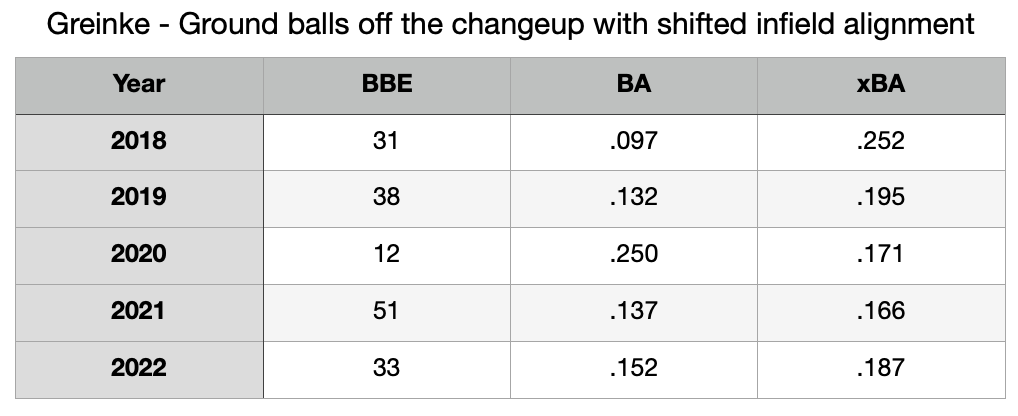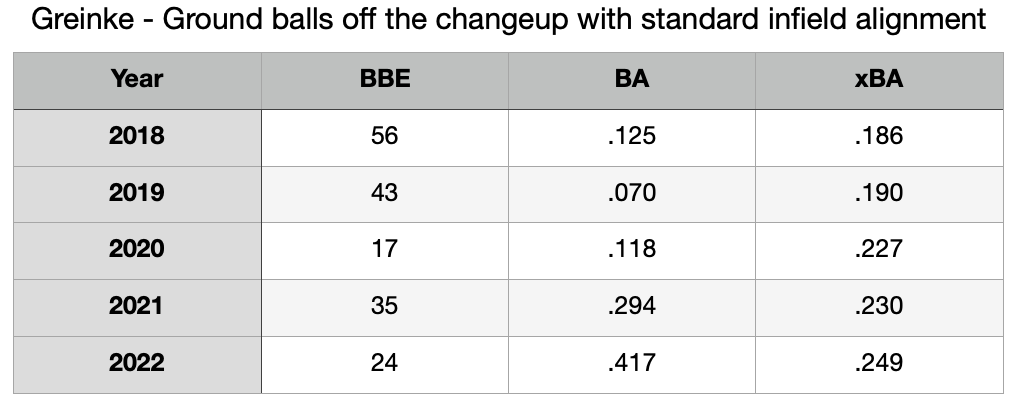Reinventing Greinke
The veteran starter looks to alter the shape—and results—of his changeup, the Royals sign some depth for the outfield and they just keep laying waste to the Cactus League.
Yesterday, I referred to the Royals as the Kings of the Cactus League. Clearly, I wasn’t kidding. Another day, another exhibition win for the boys in the blue. This time, an 8-6 comeback win over the Rockies.
In his first outing of the spring, Brady Singer channeled the 2021 vintage Singer. He jumped ahead of the first batter 1-2 and then couldn’t efficiently put him away, finally retiring Yonathan Daza on a comebacker on the ninth pitch of the at bat. After setting down Kris Bryant on strikes, Singer then couldn’t find that elusive third out. Single, walk and single let to a run and an elevated first inning pitch count. Thirty pitches in the first meant he couldn’t make it through his scheduled two innings and was pulled with two outs and 45 pitches in the second.
Nick Loftin cashed in a pair of runs with a two-out double in the fourth, but it was left to the scrubs to put together a five-run rally in the ninth to keep the Royals atop the Cactus League standings.
At this point, it would probably be easier to list the Royals pitchers who didn’t visit Driveline for some offseason work.
As Anne Rogers reports, Zack Greinke is still looking for ways to get better.
Greinke, 39, went to Driveline in Arizona this offseason, something he’s never done before in the past. He worked with trainers at the data-driven facility a little on his velocity but more on pitch design and helping his pitches work better after evaluating last season and the way hitters picked up his stuff.
Greinke enjoys using data to gain insight on his pitches -- it’s part of what’s made him effective as he gets older, as well as his willingness to change.
“I like it a lot because I believe in it,” Greinke said. “All those number things. Especially because in Houston, they would call guys up that weren’t even good prospects. And they’d say, ‘This guy’s going to be good because his pitches do this.’ And the pitcher ended up being good.”
Of course, I just love this quote. Can’t you just see Greinke buttonholing someone from baseball ops and telling them the guy they called up wasn’t a good prospect?
A specific point of polish for Greinke is his changeup and how it’s frequently pulled on the ground. With the rule change eliminating the shift, refining the change, a pitch that has paid dividends for Greinke in his career, is vital to his continued effectiveness.
The following table is how Greinke fared when his changeups were hit on the ground with a shifted infield defense behind him over the last several years. The data is pulled from Baseball Savant.
Perhaps we can make the statement that Greinke is one of the pitchers who has benefitted from the shift. But the change has been such an effective pitch for him, I’m not really certain that’s the case. The next table is how Greinke performed when his changeup was put in play on the ground with a normal infield alignment behind him.
Holy moly. The batting average from 2022 is a bit of a small sample, but still…a .417 BA? What changed?
First, and probably most obvious, was Greinke’s uniform. The Royals’ defense wasn’t exactly a strength last year. (And before you ask, yes I looked at the number of times Hunter Dozier was on the infield with Greinke on the mound. The answer is XX times. He played X games at first and X games at third.)
Still, that doesn’t account for everything. Take note of the xBA column. It’s creeping a bit higher over the years and took a mighty leap last season. The reason is opposing hitters are making better contact against his changeup. The average exit velocity on Greinke’s change, when hit on the ground, averaged about 84 MPH from 2018 to 2021. Last year, that average exit velocity jumped to 88.5 MPH.
So yes, with a changeup that hitters are making better contact against, and pulling it to boot, that means that the elimination of the shift is probably going to bring a negative impact to Greinke’s performance. If he didn’t change anything.
So it’s fantastic news that Greinke, toward the close to was is a Hall of Fame career, is looking to regain the edge that he may have lost last year. Especially now the rules will prevent a Band-Aid from being applied in the form of an infield shift.
It will be interesting to document how the lessons learned from Driveline will be applied by Greinke this summer.
With the loss of Drew Waters to an oblique strain and now Diego Hernandez with a dislocated shoulder, the Royals’ outfield depth was looking a little thin. General Manager JJ Piccolo hinted that they were working to rectify that situation.

I was figuring that meant signing one of the remaining free agents. Looking at FanGraphs free agent tracker, the pickings were slim. Jurickson Profar who was crowdsourced for a three-year and $30 million contract at the start of the winter is the lone outfielder of any quality. At this point, he’s not getting that deal.
Even on a bargain bin, early spring reduced rate deal, that’s a bit of cheddar for the spend-averse Royals. Especially if they’re adding depth. That leads us to Jackie Bradley Jr., who hasn’t put up a full season of decent offensive production since 2016. The defense still plays and we know the Royals are always looking for someone who can patrol the acreage at The K.
The signing was made official on Wednesday evening.
It’s a minor league deal, which mitigates any risk for the Royals, prevents them from having to make a transaction to open up a spot on the 40-man roster and certainly serves the purpose of adding depth. Maybe the Royals will decide to break camp with Bradley as a late inning defensive replacement specialist. While the defense does still play, it’s difficult to see how he can hit enough to justify even spot starts in the outfield.
The 2020 season was a small sample blip. He’s really fallen offensively since the start of the 2021 season. The bat has undermined what continues to be stellar defense. Bradley was worth -1.6 fWAR in 2021 and -0.1 fWAR last year.
It’s interesting to look at his OPS+ over the years and apply that to his overall performance through fWAR. From 2017 to 2019, he was good for around 2.0 fWAR, despite being about 10 percent worse than league average with the bat. Knock 30 points off that OPS+ and he becomes a replacement-level player like we saw last year. Shave another 25 off that and you have another Hunter Dozier in the lineup.
There’s a lot of the exhibition season remaining. I’m not convinced Bradley breaks camp with the team. If he does, I imagine his time in Kansas City will be relatively short. At least until Waters is back in action.
The loss of Waters and Hernandez further highlights something JJ Piccolo brought up back in January—the 40-man roster, as currently constructed, is imbalanced; there are 16 position players on the 40-man. That’s less than ideal. And two of them are Waters, who is sidelined at least for another month, and Hernandez, who is on the 40-man to protect him from the Rule 5 draft and didn’t figure to play a role in the majors at this point in his career.
As usual for the spring, there will be a bit of roster movement ahead. With Franmil Reyes (presumably) needing a spot on the roster and maybe someone else like Johan Camargo or the newly inked Bradley, there’s going to be some transactions designed to create space. More injuries will come. And the Royals may decide to dip into that bullpen depth they’ve built to pull the trigger on a trade or two before Opening Day.
March figures to be a very busy month for Picollo and the Royals.
The Royals have mapped out their pitchers for the next two games.
Thursday vs. Los Angeles Angels: Mike Mayers, Amir Garrett, Josh Staumont, Jose Cuas, Ryan Weiss, Austin Cox
Friday at Oakland: Brad Keller, Scott Barlow, Dylan Coleman, Richard Lovelady, Nick Wittgren
The march to the Cactus League title continues.












That sound you hear is Ryan Lefebvre gearing up to make dozens of on-air references to Jackie Bradley Jr. being teammates with Whit Merrifield at South Carolina.
As someone who has no life I scrolled through the schedule and determined that a pitcher can get 24 home starts without ever pitching on the road. It is hard to imagine Q doing that but we might see him toying with the rotation to get Grienke more home starts.